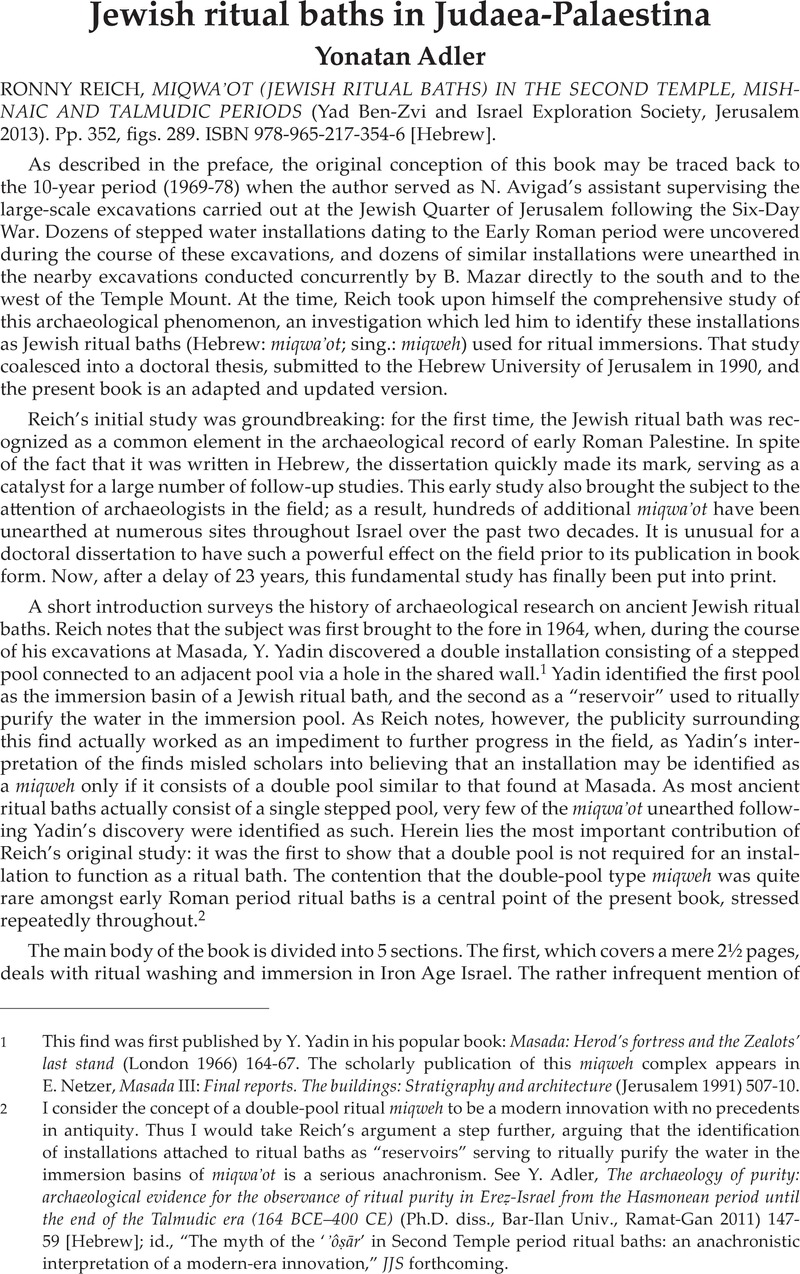No CrossRef data available.
Published online by Cambridge University Press: 27 November 2014

1 This find was first published by Y. Yadin in his popular book: Masada: Herod's fortress and the Zealots' last stand (London 1966) 164–67Google Scholar. The scholarly publication of this miqweh complex appears in Netzer, E., Masada III: Final reports. The buildings: Stratigraphy and architecture (Jerusalem 1991) 507–10Google Scholar.
2 I consider the concept of a double-pool ritual miqweh to be a modern innovation with no precedents in antiquity. Thus I would take Reich’s argument a step further, arguing that the identification of installations attached to ritual baths as “reservoirs” serving to ritually purify the water in the immersion basins of miqwa’ot is a serious anachronism. See Adler, Y., The archaeology of purity: archaeological evidence for the observance of ritual purity in Ereẓ-Israel from the Hasmonean period until the end of the Talmudic era (164 BCE–400 CE) (Ph.D. diss., Bar-Ilan Univ., Ramat-Gan 2011) 147–59 [Hebrew]Google Scholar; id., “The myth of the ‘’ôṣār’ in Second Temple period ritual baths: an anachronistic interpretation of a modern-era innovation,” JJS forthcoming.
3 Namely, the outskirts of Jerusalem, the Judean Desert, the Judean lowlands, the Jordan valley, the Hebron hills, the valley of Beersheba and the northern Negev, the Galilee and the Golan, Samaria, the hills of Benjamin, the Carmel range, the coastal plain, and Transjordan.
4 E.g., Qumran, Masada, Gezer, Marisa, and the Hasmonean and Herodian palace complexes at Jericho.
5 As Reich notes, Lieberman, S. (“Notes,” in Rosenthal, E. S. [ed.], P’raqim: Yearbook of the Schoken Institute for Jewish Research of the Jewish Theological Seminary of America, I [Jerusalem 1968] 97–98 [Hebrew])Google Scholar was the first to notice the parallel between the Mishnah here and P.Oxy. 840; yet Reich himself was the first to point out the connection between these texts and the archaeological finds. Both scholars cited another source, the Letter of Aristeas (106), which may possibly be related to our subject, but the association, as Reich admits, is dubious.
6 See 19, 21, 172-73, 229, 252 and 270-71.
7 Neusner, J., A history of the Mishnaic law of purities XIV: Miqvaot: literary and historical problems (Leiden 1976) 155 Google Scholar; also ibid. 112.
8 Ibid. 178.
9 Ibid. 173-74.
10 E.g., Selkin, C. B., Exegesis and identity: the hermeneutics of miqwa'ot in the Greco-Roman period (Ph.D. diss., Duke University, Durham, NC 1993)Google Scholar; Lawrence, J. D., Washing in water: trajectories of ritual bathing in the Hebrew Bible and Second Temple literature (Atlanta, GA 2006)Google Scholar; Miller, S. S., “Stepped pools and the non-existent monolithic ‘miqveh’,” in Edwards, D. R. and McCollough, C. T. (edd.), The archaeology of difference: gender, ethnicity and the “other” in antiquity. Studies in honor of Eric M. Meyers (Boston, MA 2007) 215–34Google Scholar; Amit, D. and Adler, Y., “The observance of ritual purity after 70 C.E.: a reevaluation of the evidence in light of recent archaeological discoveries,” in Weiss, Z. et al. (edd.), “Follow the wise” (B. Sanhedrin 32b): studies in Jewish history and culture in honor of Lee I. Levine (Winona Lake, IN 2010) 121–43Google Scholar.
11 My 2011 study (supra n.2) listed 850 baths (pp. 319-43).